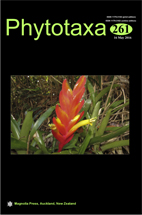Abstract
Natural hybridisation is considered a common fact among species of Bromeliaceae. We here report natural hybridisation between two sympatric Vriesea species, V. incurvata and V. carinata, in the Atlantic Forest of Santa Catarina (southern Brazil), one of the main remnants of the Mata Atlântica forest. Morphological and genetic data were obtained from both parental species and the putative hybrid, individuals of the latter being found to be intermediate between those of the parents. The main differential characters of the nothospecies were the width of the inflorescence and the rachis, length and width of the stigma, and the length of anthers. Moreover, plastid markers and nuclear microsatellites were analysed and we found that the hybrid plants shared genetic information with both parental species, although they showed an overall higher genetic similarity with V. carinata. As a conclusion, the hybrid status of the intermediate plants is accepted and therefore the new nothospecies V. × brueggemannii is described. To date, the presence of the hybrids is restricted to regeneration sites, a fact that points out to the need for preservation of the secondary vegetation as an effective tool for conservation of biodiversity.

